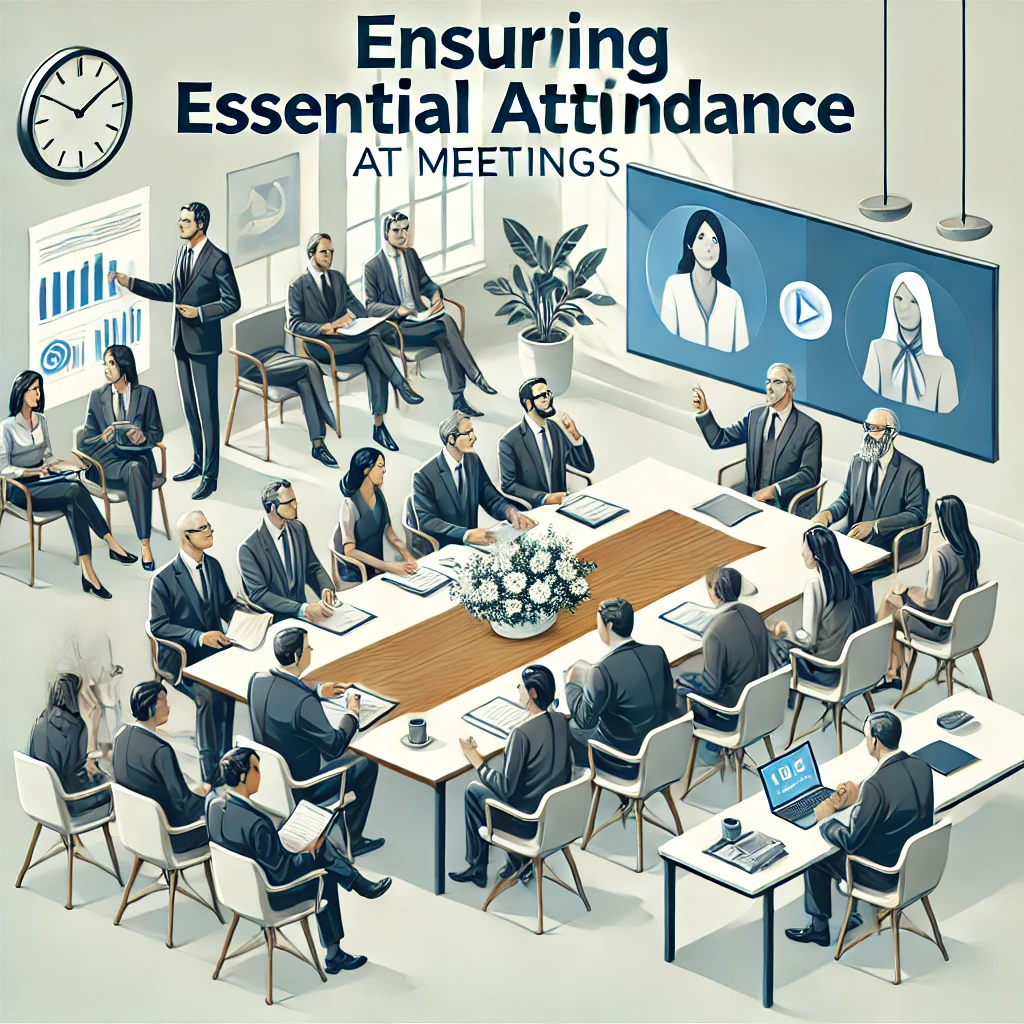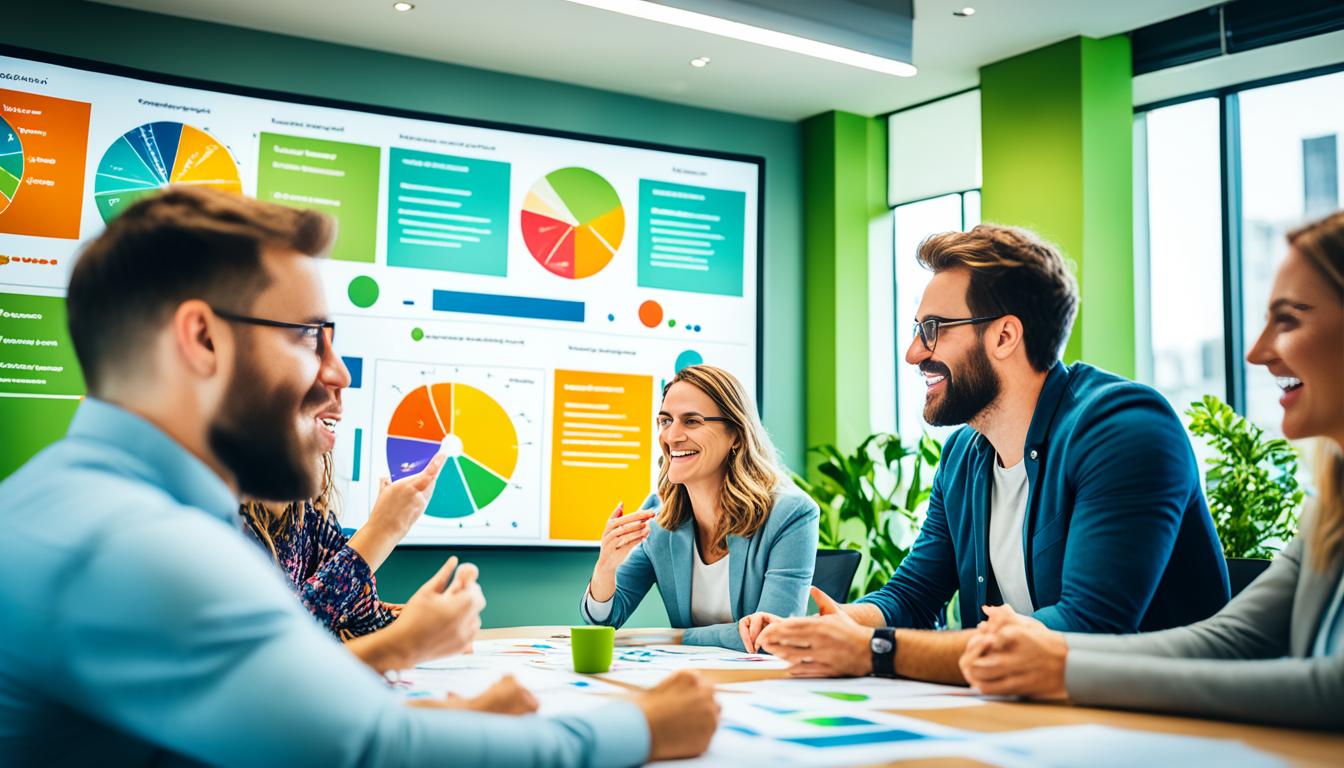Effective monthly meetings boost team spirit and work quality. They share company values and news, keeping everyone involved. Use tools like Zoom or Microsoft Teams for better remote participation.
Polly’s all-hands meetings are held twice a month, after trying different schedules. The right timing and setup depend on the company’s size and its communication style. Such meetings must be open to promote new ideas and trust within the organization.

At Polly, we welcome new faces with big celebrations to build a strong team. It’s important to talk and listen, as it brings the staff closer. Q\&A moments help, but time and question quality can be issues. So, it’s good to plan how these discussions will go.
Have a clear agenda and share it before the meeting to keep things on track. Using visuals like slides helps everyone understand better. Adding fun stuff and icebreakers can also make the gathering more interesting. This keeps people focused and willing to participate.
Define the Purpose of Your Meeting
In the New Age of Work, how we meet has changed. We meet in person, online, or both. Before every monthly meeting, it’s key to know why it’s happening. This makes sure everyone focuses on important issues. At Ninety, meetings are about getting and sharing info, solving problems, creating ideas, and building trust.

Clarifying Objectives
It’s important to set clear goals for your meeting. These goals need to be clear and useful. Ninety does this well by having meetings weekly, quarterly, and yearly. They focus on making sure everyone knows what to do. This helps the team move together. At big meetings, Ninety looks at long-term plans. At others, they work on fixing current problems with a special process.
Deciding if a Meeting is Necessary
Think hard before setting a meeting. Is it the best way to talk? Sometimes, emails or chats can do the job. Ninety prefers looking forward, not back. This can improve things without a big meeting. They focus on important goals, budgets, and plans without wasting time. It’s also smart to not meet around meal times or very early or late. This helps everyone be more involved.
Set a Meeting Agenda
Creating a clear meeting agenda is key to a successful monthly meeting. It’s like a map, showing the topics, activities, and who leads each part. This makes sure the meeting runs smoothly and everyone knows what to expect.
Sharing the Agenda Ahead of Time
Telling everyone about the agenda early is really important. It helps people get ready and share their thoughts. This makes sure all important points are discussed. Sharing the agenda in advance also helps the meeting go more smoothly.

Getting feedback from everyone before making the final agenda makes it better. This includes important topics and questions. It keeps discussions on track and meetings focused.
Allocating Specific Time Slots
It’s important to use time well in meetings. Each agenda item needs its own time set aside. This helps everyone respect each other’s time and keeps the meeting on track. Remember, each topic needs just enough time based on its importance.
Also, having someone to guide each part can make meetings more effective. Facilitators help discussions stay focused and make sure everyone gets a chance to speak. This makes the meeting more interactive and productive for everyone.
Include Feedback and Interaction
It’s really important to involve employee feedback and include interactive meetings. Doing this makes team engagement better and meetings more effective. Research by Gallup shows that when employees are engaged, they perform a lot better. Giving people a chance to speak up in meetings helps build a culture of openness and trust.
Employee feedback is key. Surveys after meetings let bosses and team leaders spot big problems and find areas to get better. These surveys make sure meetings are hitting their goals and help them get better over time.
When employees are encouraged to fill out surveys right after a meeting, more of them do it. Studies show that happy employees are 12% more productive, and those who aren’t into their work are 10% less productive. Adding activities like live polls and Q\&As can make meetings more fun and help everyone talk more openly.
Good communication and working together are crucial for a business to do well. Having a clear agenda for meetings and sticking to a schedule helps. It lets everyone have their say and makes sure feedback is listened to. Asking for feedback often and making meetings interactive can help keep employees happy and working hard.
For better team engagement and higher productivity, including feedback and interactive activities in meetings is a must. This way, you get more than just better involvement from employees. You also build a strong, welcoming culture in the workplace.
Include Key Participants Only
Meetings work best with only core team members, especially those who make key decisions. This approach avoids crowding and helps get to the point. It also makes sure everyone knows and tackles the problems at work.
Identifying Key Decision Makers
Picking the right decision-makers is key. They help keep things moving. Most senior managers say some meetings are not helpful. So, focusing on these crucial people keeps meetings useful and on track.
Figuring out who is most needed in the meeting is smart. This way, decisions can be made and plans put in action. Brainstorming in advance with these special folks can really make a difference.
Ensuring Essential Attendance
Being careful about who shows up is vital for good meetings. It stops meetings from getting too full and losing their focus. Regular team gatherings help everyone keep up with the company’s goals.
While online tools are great for some discussions, big decisions need key players present. Learn more about choosing the right meetings here. This will help your team have better, more meaningful discussions.

When adding more people to a meeting, watch this guide on “how to invite without all the. Following this advice will keep your gatherings smooth and on topic.
```
Using this HTML in your article showcases why it’s crucial to have only essential people in meetings. This practice boosts meeting efficiency and teamwork.
Utilize Visual Aids for Clarity
Using visual aids in your talks is key for clear communication. It makes your points clearer and helps people remember them better. This is especially true for monthly meetings.
Keep each PowerPoint slide brief, around ten words. This focuses on what’s important and doesn’t confuse your audience. Use charts, timelines, and graphs to show your points clearly.
Vary your visual aids, including sound and video. Make sure any videos are short and fit your main point. PowerPoint is great for this.
Always have a backup ready for technical issues. This keeps your talk running smoothly, avoiding confusion. Visual aids are also super helpful for brainstorming. Sticky notes and sketches can turn ideas into concrete plans.
Visual aids make working together fun and more creative. They help break down complex topics, sparking new thoughts. Spend time making good visual aids for a talk that’s interesting and clear.
Run a Q\&A Session
Holding a Q\&A during monthly meetings is key. This encourages open talks and boosts engagement. When you get ready for the big questions, you make everyone feel their worries are being heard. This is important for any effective meeting.

Preparing Common Questions
Think about what questions might come up. Being ready for these can make your Q\&A smoother and quicker. Experts say it’s good to have 5-10 questions ready. This way, you show you care about what your team wants to know.
Use tools to help sort the important questions. This keeps things organized. It shows your team you’re listening. What they think really matters.
Encouraging Open Communication
Getting everyone talking is a must for a good Q\&A. Let people send in questions beforehand, and also during, the meeting. This can make it more lively. Keeping 25% of the meeting just for questions means you’ll tackle every major issue.
Don’t forget the follow-up. Share a summary of the Q\&A or send answers later through your company’s channels. This clears up any last questions. Being open and clear helps everyone.
Alternate Meeting Formats
Changing up meeting styles stops them from getting boring and makes them more creative. Studies show that most workers like to take part in meetings, rather than just watch. This makes it vital to have different ways to meet that keep things interesting. For example, Fishbowl makes teams talk in smaller groups, which can lead to better chats.
Then there’s Pecha Kucha, where people look at 20 pictures for 20 seconds each. It’s fast and gets the point across. Flipped Learning is another cool method. It lets you learn before the meeting, so you can talk about it in depth during your get together.
Huddle meetings are quick and happen every day or week. They’re great for short updates. Adding games to meetings can also make them more fun and useful. Nearly everyone likes these kinds of interactive meetings.
Now, let’s talk about Hackathons. Teams work hard together for a short while to overcome challenges. This boosts teamwork and sparks new ideas. Using apps like Slack for brief meetings or feedback is yet another fresh idea. It keeps everyone connected without always being in the same room.
In the end, mixing up your meeting style with things like Fishbowl, Pecha Kucha, and Huddles fits well with today’s workers. It makes meetings more fun and everyone can contribute more. This new approach is the key to making meetings better, where everyone really takes part.
Make the Monthly Meeting Engaging
Make monthly meetings fun and informative. Add new elements to make them more engaging. This helps boost morale and keeps team members interested and participating.
Incorporating Fun Elements
Start the meeting on a good note. Have everyone share achievements or funny stories. This sets the mood for a great meeting. Use tools like Switchboard for real-time interactions. Joel Soucy of Solink says using Poll Everywhere for quizzes is fun. It keeps everyone involved. Break midway for discussions or have standing meetings. This keeps people alert and energized.

Using Icebreakers
Icebreakers make the meeting more friendly. They reduce tension. Activities like easy debates or brainstorming make team members closer. Lucjan Suski from Surfer SEO suggests encouraging everyone to join. This makes for a more engaging meet. In big virtual meets, breakout rooms can help quieter members contribute. This ensures everyone’s voice is heard.
By using these methods, meetings become more vibrant. They’re not just for work, but also for fun. Everyone looks forward to them.
Define Takeaways and Assign Follow-Up Actions
It’s key to end monthly meetings with clear outcomes and actions to follow. This step helps use the meeting’s insights well. It encourages more talks and team work later on.
Creating an Action Plan
Make a clear action plan that says what to do, who’s doing it, and when it’s due. For example, a marketing meeting might include tasks like picking a homepage design or making a presentation. Set clear dates to check on everyone’s progress. Project management tech helps by keeping all informed.
Assigning Responsibilities
It’s important to assign tasks for a successful meeting result. Make sure everyone knows their job, like Sarah must finish the layout by June 15th, and John’s slides must be done by June 5th. Tools like Kumospace are handy, especially for remote work. This way, everyone knows what must be done and when, which makes things run smoothly.

Share Relevant Documents Post-Meeting
Sharing materials from the monthly meeting helps everybody understand key points. It makes sure everyone has the same information. This way, they can check it whenever they need.
When we share what we talked about, we thank everyone who shared. It brings us together to work better as a team. Writing down what we decide and who does what helps us stay on track.
Status updates and questions are important. They prevent us from forgetting important matters. Using pictures and charts makes it easier for everyone to get the message, even those who weren’t there.
Keeping notes as we talk helps us remember everything. This leads to better notes. And it’s an important part of what we do after the meeting. Sharing these notes helps us work together better.
Conclusion
Monthly meetings are key for keeping everyone on the same page, working together, and meeting goals. They help by making clear what the meeting is for, planning what to talk about, inviting the right people, and using tools to help understand.
Using humor at the start makes meetings more fun and leads to more people joining in, with a 40% increase in taking part. Since meetings have gone online, more people attend, 30% more than in person. Good opening and closing words can make a big difference. They can make people more focused, with up to 25% better attention when the start and end are done well. It shows how telling good open and close talks is essential for teams.
Sharing notes after can help keep everyone clear on what was discussed and what to do next. A lot of people, 86%, say these notes are really important. And most, 70%, want to know what to do right after the meeting. Using ready-to-fill templates, like the ones in this template for meeting notes, makes this step smoother.
Adding these ideas to your monthly meetings can make big improvements. Listening to feedback and changing as needed is a must. And, wrapping up a meeting well is crucial, it should remind people of the main stuff and maybe end with something strong. To learn more about making a powerful end, check out this helpful guide. Using this advice will help your monthly meetings do more than just hit your goals.
FAQ
What makes a monthly meeting effective?
Effective monthly meetings need a clear goal and a plan. They should welcome everyone to share their thoughts. Visual aids help a lot, especially for teams working from different places.
How important is it to define the purpose of a meeting?
Defining a meeting’s goal is key. It focuses on what really matters for the team. This clarity brings everyone together to work toward the same target.
Why should the agenda be shared ahead of time?
Sharing the agenda early lets everyone get ready. It makes sure that all important topics get a turn. This keeps talks on track and makes better use of everyone’s time.
How does employee feedback enhance meetings?
Feedback makes meetings more engaging and alive. It boosts trust and shows that everyone’s ideas are welcome. Employees feel more connected when their role is valued in the meeting.
Who should be invited to monthly meetings?
Invite only those who really need to be there. This keeps the meeting small and more effective. Choosing the right people is important to get work done well without wasting time.
What is the role of visual aids in meetings?
Visual aids help explain things clearly and help everyone remember them better. They add a lot to what is being said. Slides, charts, or images can make complex ideas easier to understand.
What are the benefits of running a Q\&A session?
Q\&A sessions let people ask questions and get answers. It prepares everyone and makes the meeting more interactive. This helps build teamwork and keeps everyone on the same page.
Why should meeting formats be alternated?
Changing meeting styles keeps everyone interested. It’s good to mix it up with different types of discussions. This way, everyone gets something relevant from the meeting.
How can fun elements be incorporated into monthly meetings?
Adding fun things like short games or friendly discussions can break the ice and make meetings more lively. It helps people bond and can boost their creative thinking.
What is the importance of defining takeaways and follow-up actions?
Setting clear next steps after a meeting is crucial. It shows that the discussion leads to real actions. This helps to get things done and keeps the team moving forward efficiently.
Why should documents be shared post-meeting?
Sharing meeting documents later makes sure everyone is on the same page. It allows all to review and remember the key points. This keeps the team working together well, even after the meeting has ended.

More Posts
Time Management Hacks - The Complete List of Hacks that works
Can you control the clock? Can you turn back the time? Can you make it pass slower or quicker? Sadly, the answer to all the above questions is a resounding no. For better...
The 10 Best Time Management Tools for 2023
Want to manage your time better but don’t know how? Explore the 10 best time management tools, choose one, and turn time in your favor—starting now! Do you feel you never have enough...
9 Tips to Set Performance Targets at Work
In today's fast-paced work world, setting performance targets is key for business success and better work outcomes. Clear employee goals help employees understand what's expected and reduce stress while boosting confidence by offering...
7 Best Online Meal Planners (Free & Paid)
Do you find yourself constantly struggling to come up with healthy meal ideas that fit your busy lifestyle? Meal planning doesn’t have to be a daunting task - countless online meal planners can...